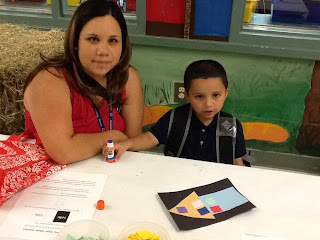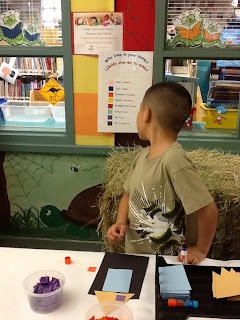 |
| Family Glyph Legend |
When the children were finished they wrote their name and their teacher's name on a label and added it to the back of their glyph. The glyphs were placed on a wall in the hallway so the classes could discuss the glyphs in order to compare and contrast the families represented.
 |
| Creating their family glyph |
 |
| Working together to represent their family. |
 |
| Checking the legend to see what color is needed next. |
 |
| Everyone is included in the activity. |
 |
| Making the home with a triangle and rectangle. |
 |
| Parents and children working together. |
 |
| Adding her own creative touch to the glyph. |
 |
| Family Glyph activity at Family Night @ the Library. |
 |
| Adding the people who live in his home. |
 |
| Creating a symbolic representation of the people who live in his home. |
 |
| Final product |
 |
| Too busy to look at the camera. |
 |
| Adding a red square (grandparent) to the family glyph. |
 |
| Final Hallway Display |
Once the children were finished creating their family glyph, we put them up on the wall in the hallway. Here are some of the questions I asked the children once their glyph was on the wall.
1. How many people live in your home?
2. Can you see another person who has the same number of people living in their home?
3. Do you see another family glyph that looks exactly like your glyph.
4. We looked at the child's glyph and one other, and talked about which one has more, less. Are there any people who live in your home, but not in the other persons.
5. Looking at all of the family glyphs, or one line of glyphs, which home has the most people living in their home? Which home has the least number of people living in their home?
By asking these thinking questions, we are making the children analyze the data they see represented in the family glyph. Glyphs are a great way for young children to "read" information by simply using a symbol for each of the characteristics / items represented in the legend.
No comments:
Post a Comment